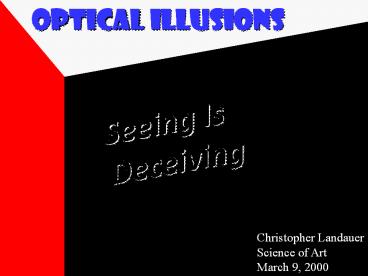Optical Illusions - PowerPoint PPT Presentation
Title:
Optical Illusions
Description:
Optical Illusions. Seeing Is Deceiving. Christopher Landauer. Science of Art. March 9, 2000 ... Optical illusions mock our trust in our senses ... – PowerPoint PPT presentation
Number of Views:1372
Avg rating:3.0/5.0
Title: Optical Illusions
1
Optical Illusions
Seeing Is Deceiving
Christopher Landauer Science of Art March 9, 2000
2
What is an Illusion?
- illusion (î-l¹zhen) noun
- 1. a. An erroneous perception of reality.
- b. An erroneous concept or belief.
- 2. The condition of being deceived by a false
perception or belief. - 3. Something, such as a fantastic plan or desire,
that causes an erroneous belief or perception. - 4. Illusionism in art.
- Latin root of illusion is illudere which means
to mock - Optical illusions mock our trust in our senses
- Suggest that the eye is not a passive camera
rather, - perception is an active process that takes
place in the - brain and is not directly predictable from
simple - knowledge of physical relationships
3
Whats the big deal?
- Human reliance on correspondence between
conscious experience and physical reality - Continual verification of our senses
- Cultural Heritage
- Seeing is Believing
- See it with my own two eyes
4
History of Illusions
- Prehistory
- Afterimage caused by glancing at the sun
- A stick half in and half out of water
5
History of Illusions
500 B.C. - Height of the Greek Period The
eyes and ears are bad witnesses when they are at
the service of minds that do not understand their
language -Parmenides Two Viewpoints on
Perception 1. Sensory inputs are inaccurate.
Mind corrects these inaccuracies to provide an
accurate representation of the environment. Illus
ions Senses are relied on more than the
Mind 2. Senses are inherently accurate and
produce a true picture of the environment.
Mind is limited. Illusions Mind interferes with
the Senses
6
History of Illusions
c. 450 B.C. The mind sees and the mind hears.
The rest is blind and deaf. -Epicharmus Man
is nothing but a bundle of sensations -Protago
ras c. 300 B.C. We must perceive objects
through the senses but with the mind -Plato
384 - 322 B.C. Each sense has one kind of
object which it discerns, and never errs in
reporting that what is before it is color or
sound Although, it may err as to what it is
that is colored or where it is, or what it is
that is sounding, or where it is. -Aristotle
7
History of Illusions
- A. Ideal Parthenon
- B. Architrave Illusion
- (Jastrow-Lipps)
- C. Illusionary Distortion
- D. Alterations made to offset illusion
8
History of Illusions
For the sight follows gracious contours and
unless we flatter its pleasure by proportionate
alterations of the modules--so that by adjustment
there is added the amount to which suffers
illusion--an uncouth and ungracious aspect will
be presented to the spectators. -Vitruvius
9
History of Illusions
Entasis Convexing of column to overcome
parallel lines appearing concave Irradiation
Illusion Bright objects appear larger
10
History of Illusions
Conclusion More of an Art than a
Science Early Preparadaigmatic
Science -Trial and error -Aesthetic, not
scientific -No factual understanding -No
treatsies -No schools of thought
11
History of Illusions
1596 - 1650 Descartes There is both a
registration stage and an interpretation stage in
the perceptual process. Perceptual error or
illusion may intrude at either of these two steps
along the road to consciousness. 1700 - 1800
Given at Birth vs. Learned through
Experience Reid Kant All knowledge
of the external world comes directly
through the senses and is interpreted by innate
mechanisms Berkeley Hume
All perceptual qualities are learned through
experience with the environment
12
History of Illusions
- 1800 - 1870 Experimental Foundations
- Mueller, E.H. Weber, Helmholtz, Baldwin, Hering
use Physics, Physiology, Philosophy to form
treatises - Specialist and Non-specialist working in area of
visual geometric illusions carrys on to the
present - 1922 - Luckiesh lighting engineer 1964 -
Tolansky physicist 1972 - Robinson
psychologist - 1900s Revolution and Rebirth
- Behaviorists vs. Gestalt
- Methodology vs. Theoretical
- Percepual response Brain wave patterns
13
Current State of Illisions
Conclusion Paradigmatic Science
(Psychology) 1900s Normal Sciences gt
Anomoly gt Crisis gt Revolution Current status
Normal Science - mopping up - puzzle
solving - guidelines for research
14
Ambiguous Figures
Face or Vase?
15
Ambiguous Figures
RetroActive Nels Isralson
L'Amour de Pierrot c.1905
Gossip and Satan Geo. A. Wotherspoon
16
Ambiguous Figures
Bust of Voltaire - Houdon, 1781
Slave Market With the Disappearing Bust of
Voltaire - Salvadore Dali, 1940
17
Ambiguous Figures
The Great Panoramic - Salvadore Dali, 1936
18
Ambiguous Figures
Multiple Figures
2
3
2
2
19
Ambiguous Figures
Mask Concavity
20
Ambiguous Figures
Machs Figure
21
Ambiguous Figures
Schroders Staircase
22
Ambiguous Figures
Oscillating Cubes
23
Ambiguous Figures
Necker Cube
24
Ambiguous Figures
25
Ambiguous Figures
Cube looks like a cube. Equal sides and right
angles. Eye Perspetive projection Reverse
Topless pyramid change of shape
Cube looks distorted, on face smaller than the
other. Depth is paradoxical Reverse No Change
26
Ambiguous Figures
Cube does not look like a cube. Eye Near face
is same size as far face Reverse Topless
pyramid further face always looks larger
Necker Cube. No face is front or back by
perspective Depth is paradoxical Reverse No
change
27
Ambiguous Figures
- Possible views
- Cube with corner missing
- Box in corner of room
- Small cube infront of large cube
3 in 1 Illusion
28
Ambiguous Figures
Cube / Room
- Possible views
- 3D Cube
- Corner of Room










![Download Book [PDF] 3d drawing and optical illusions: A Step-by-Step Guide for Drawing Optical PowerPoint PPT Presentation](https://s3.amazonaws.com/images.powershow.com/10070071.th0.jpg?_=20240702110)
![❤[PDF]⚡ The Art of Optical Illusion PowerPoint PPT Presentation](https://s3.amazonaws.com/images.powershow.com/10071230.th0.jpg?_=202407030712)





![get [PDF] Download how to draw optical illusions and 3d art: A Step-by-Step Guide for Drawing PowerPoint PPT Presentation](https://s3.amazonaws.com/images.powershow.com/10070070.th0.jpg?_=20240702111)







![⚡Read✔[PDF] Mindscapes: Escher's Challenge: Optical Illusions PowerPoint PPT Presentation](https://s3.amazonaws.com/images.powershow.com/10059742.th0.jpg?_=20240619119)





